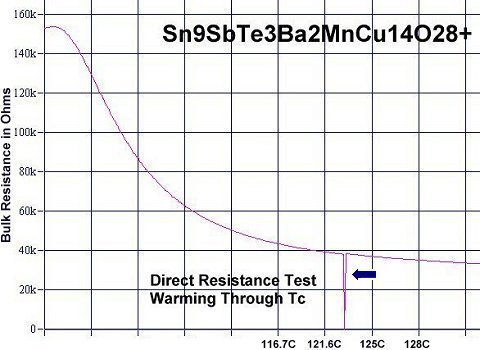
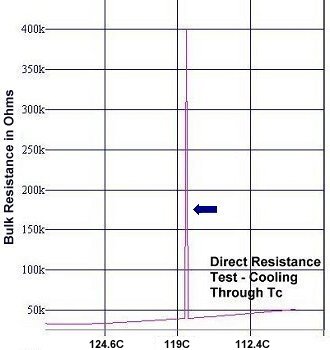


Recently Superconductors.ORG announced the discovery of two new room-temperature superconductors. Both were confirmed by sharp resistive and diamagnetic transitions. But one of those discoveries was unique. The bulk of non-superconductive Sn9SbTe3Ba2MnCu14O28+ is on the threshold of a Mott transition. Since prior research has found a correlation between superconductivity and the Mott transition1,2, minority phase superconductivity in this material can be confirmed by a third means.
A Mott transition, by definition, occurs when a material transforms from an insulator to a metallic state. Sn9SbTe3Ba2MnCu14O28+ shows superconductivity near 120 Celsius when it forms with the P212 structure (shown below left). However, more than 99% of the bulk is comprised of other structures and is predominantly semi-conductive. Mott transitions can be triggered in a semiconductor by changing the electron density. So, as the Sn9SbTe3Ba2MnCu14O28+ superconductor moves through its critical transition temperature (Tc), the electron density of the surrounding semiconductor is affected. This "active doping" initiates the Mott transition.
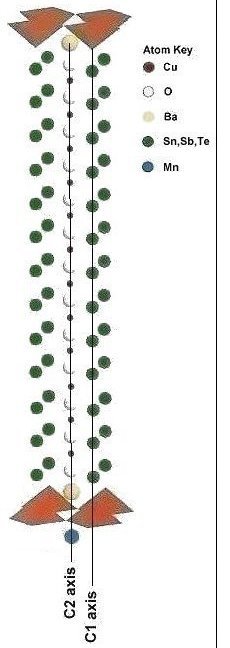
|
At page top are plots showing the Mott transitions (see small arrows). The upper left plot shows the material being heated through Tc. Just above 120 Celsius superconductivity quenches and the paired electrons are released to flood the bulk, causing an over-doped condition in the semiconductor. This triggers the Mott transition to a metallic state and the resistance suddenly drops. But only for a moment. The electrons quickly return to their atomic sites. In the upper right plot, just the opposite happens. As the bulk is cooled through Tc, the electrons move to pair up and there is a brief under-doped state in the semiconductor. This triggers a Mott insulator and resistance jumps to above 400K ohms3. Again this is a transient event. Since the Mott transitions are short-lived, capturing them with logging software was difficult. However, through repeated testing more than 10 transitions were recorded - and they all occurred at the superconductive Tc. The below graphics zoom in on the transition gap, which clearly shows a resistance shift of 400-500 ohms where the curve breaks and then resumes. This confirms that the Mott transitions are occurring at the same instant as the superconductivity transitions. 
 |
The below magnetization plots verify that the 400-500 ohm resistance changes originate from superconductivity. Superconductivity is the only phenomenon in the physical sciences that can explain sharp resistive and diamagnetic transitions at the same temperature. Both of the magnetization plots clearly show Meissner transitions near 120 Celsius (up is more magnetic, down is more diamagnetic). The straight lines approximate the average of the data points, skewing apart at Tc. The signal is noisy due to the inherent thermal noise at these temperatures and a low volume fraction (VF) of the desired phase.
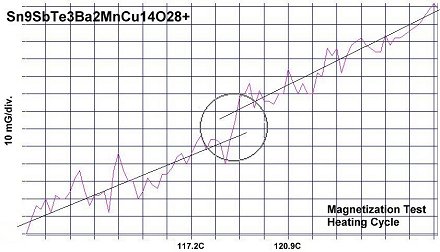
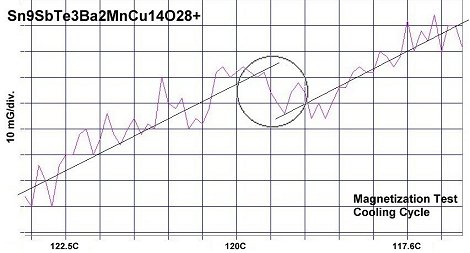
In order to maximize formation of the P212 structure, Sn9SbTe3Ba2MnCu14O28+ was synthesized using the layer cake method, as shown below. The pellet had approximately 100 interference layers. And, even using this layering technique, the VF is low, requiring very sensitive test equipment.
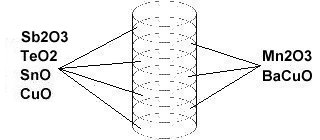
Stoichiometric ratios of the below chemicals were used for the ODD layers:
SnO 99.9% (Alfa Aesar) 8.77 grains...and the below ratios for the EVEN layers.
BaCuO 99.9% (Alfa Aesar) 3.14 grainsThe chemical precursors were pelletized at 60,000 PSI and pre-sintered for 24 hours at 715C. The pellet was then sintered for 10 hours at 880C and annealed for 10+ hours at 500C in flowing O2. Temperature was determined using an Omega type "T" thermocouple and precision OP77 DC amplifier. The magnetometer employed twin Honeywell SS94A1F Hall-effect sensors with a tandem sensitivity of 50 mv/Gauss.
RESEARCH NOTE: The copper-oxides are strongly hygroscopic. All tests should be performed immediately after annealing.
RE-PUBLICATION NOTICE: Elsevier Publishing, dba Elsevier Science, as well as Morris Communications, both print and broadcast divisions, are specifically prohibited from re-publishing any part of this news story.
E. Joe Eck
© 2015 Superconductors.ORG
All rights reserved.
1. Enhancement of superconductivity close to a Mott transition, Capone, et al,
Journal of Magnetism and Magnetic Materials 272-276, Supplement, May 2004, E133-E134
2. High temperature superconductivity near a Mott transition, De Cao, Tian, arXiv:0906.2130, 12 June 2009
3. Since the digital multimeter was in "auto-range" mode, a transient measurement above 400K ohms will read as "off scale".
 BACK to "News" page at Superconductors.ORG
BACK to "News" page at Superconductors.ORG